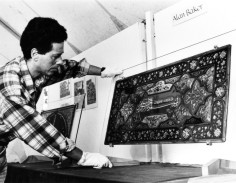
| TECHNIQUES OF STAINED GLASS FOR EXPLORING ISLAMIC ART |  |
BackgroundThe background to the techniques that I developed which enabled me to interpret Islamic designs into stained glass works of art began when I came across the Middle Eastern technique of stucco coloured glass windows during a visit I made to a studio where the restoration of a Victorian copy was being carried out. The originals are at La Zisa, near Palermo, Sicily, and the copies are to be found in the Arab Hall, Leighton House, London. I became intrigued with this technique, where small pieces of glass are set into plaster of Paris, and noticed that the pierced work of the plaster was shaped and slanted. It was not until later, when I saw these windows in situ, that I realised that the angle of the cut in the plaster was regulated according to the height of the wndow above the spectator. Windows of the EastWhen I began to further research this area in the UK I found very little information on the techniques of making stucco coloured glass windows. There was one book however, that did describe this technique, written about 1880 by a plaster worker, William Millar, in Plastering - Plain and Decorative, a comprehensive work full of information and useful advice. This book describes, and illustrates, one of eleven windows now stored in the Victoria and Albert Museum, London, To find early examples of this tradition, I had to look for information mainly to be found in the museums. The Ashmolean Museum (University of Oxford) has one of the earliest examples of crown glass is from Jerash, Jordan, dating from the 7th century, and plaster fragments with coloured glass set into it from Hira during the 8th century. Glass of the EastThe making of coloured glass sheets is thought to have originated in Syria and as I looked further into this I came across the well known glass goblet known as "The Luck of Eden Hall" made in Syria, probably Aleppo, about the middle of the 13th century, and now in the Victoria and Albert Museum, London. The tradition of enamel painting on glass and on the later mosque lamps may well have contributed to the glass painting techniques that developed in Europe. Explorations into Islamic ArtWith my growing interest in Islamic Art, together with encouragement from a friend, Dr Nabil Safwat, I began to seek new ways of interpreting pieces of Islamic Art and to produce stained glass panels that would capture the richness of detail and decoration found in these works. An Iznik plate was the first piece that I began to interpret into glass. This proved to be quite a challenge, as it involved carefully etching flashed glass (a two layer glass, in this case blue on clear) with acid, painting it on, then carefully removing the glass to produce a "blushing" effect, and finally painting with enamel pigments before firing the glass. Then followed two panels based on Islamic manuscripts which featured calligraphic inscriptions. With the first panel I further developed the technique of painting with enamel pigments, something seldom used now in the West to any extent. With the second I was inspired by the richness of the design and began, in addition, to explore ways of increasing the richness of the surface texture of the glass. Development of TechniquesTo achieve this I had to employ new techniques as well as employing traditional ones. By constant experimentation I found various ways of enhancing and enriching the glass surface. After etching the glass I discovered ways of slumping (bending) and forming the glass. This involved placing a shaped flat etched glass piece over a plaster mould, placing it in a kiln, heating it and then allowing the glass to take on the shape and form of the mould. After it had cooled the glass was then painted with enamel pigments, which were then fired on to the surface of the glass. I also discovered that I could cast glass into moulds using a low melting point glass, and then decorating the casts with enamel pigments before finally leading all these together to form the completed piece - a very time consuming procedure. Further AdaptationsIn more recent works I was again encouraged by Dr Safwat to undertake research into and interpretation of a form of manuscript known as the Hilya. I have completed two panels based on this form which entailed reproducing the work of the 17th century Ottoman calligrapher Hafiz Osman. I was able to transfer the calligraphy on to glass by using the contemporary technique of silk screen printing. The illumination was inspired by the Iraqi, Hashem al-Khattat (1917-73). Here I used computer scanning and stencil making which allowed me to etch the glass in very fine detail before hand-painting with enamels. The work of a Turkish friend, Asiye Kafalier, a manuscript illuminator, has also been an inspiration, and I am at the moment experimenting with the 15th century traditional Turkish art of Ebru (marbling) which I have been able to realize in glass. I have also begun to use lustres containing precious metals and also gold to enhance the decorative surface of the glass. |